![]()
Misconception
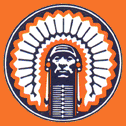 Kentucky only got to the final four in 1984 out of sheer luck and cheating. Illinois was the better team but was robbed of their final four ticket by the referees and the NCAA who let Kentucky play on their home court for the Regionals.
Kentucky only got to the final four in 1984 out of sheer luck and cheating. Illinois was the better team but was robbed of their final four ticket by the referees and the NCAA who let Kentucky play on their home court for the Regionals.
![]()
The Facts
Kentucky beat Illinois 54-51 in the Mideast regional finals in 1984. Illinois was having an excellent year, earning a co-championship in the Big-Ten conference. They were led by players such as Efrem Winters, Doug Altenberger and Bruce Douglass.
Kentucky had assembled an incredible team in 1984. Sam Bowie, their 7 foot 1 All-American was finally healthy after a number of seasons of serious injuries. He was joined by 6 foot 10 Melvin Turpin, a big center with an excellent shooting touch and Kenny Walker, a wiry 6'8 forward who would later in his career become a first team All-American and finish his career as the number two all-time leading scorer at Kentucky.
The game was closely played but came down to two key plays by the quick Kentucky guard Dicky Beal. Coming off a time-out with under a minute to play, Beal took the ball and dribbled around the perimeter killing clock. He saw an opening down the left side of the lane, took it and squirted in for a lay-up to put UK up for good. Later, Beal had the ball on a break-out. He crossed half court and put on the brakes because three Illini defenders were converging on him. His momentum caused him to go forward a step, however he kept his pivot (back) foot down. A time out was signaled and called for by Beal. Illini fans claim that Beal traveled on the play.
After the game, Illinois head coach Lou Henson remarked "we couldn't win, we had no chance under the conditions presented here." He continued "The thing is we played such a courageous game and we lost, nevertheless. A break here and there and we, not Kentucky, would be on the way to the Finals next weekend in Seattle."
A few years later, the NCAA instituted a rule stipulating that no team can play on their home floor during the regionals. This was later expanded to include first and second round games.
![]()
Rebuttal
Kentucky won the game on the court in a head-to-head matchup and that is all that should matter. For those who are interested, the fouls were called 15-14 in Kentucky's favor. No player on the Illinois team had more than 3 fouls in the game.
If people want to claim that Illinois was the better team, that simply was not true. Kentucky had shown through the season that they were a legitimate contender for the title (along with Houston, Georgetown and North Carolina). They earned their number one seed by going 26-4 prior to the tournament, winning the SEC regular season title and the SEC tournament. It was unfortunate that Illinois had to play in Rupp Arena but those were the rules at the time and Kentucky earned the spot they received.
Illinois was only a third seed in the tourney. Kentucky played Illinois earlier in the season in Champaign under extremely adverse travelling conditions and won. They also beat the other Big Ten co-champion Purdue along with Indiana that season.
Jim Savage claims in his book The Encyclopedia of the NCAA Basketball Tournament that "Beal careened into Illinois's Bruce Douglas just across midcourt - and the call went against Douglas." This claim is incorrect in that as mentioned, the difference in opinion had to do with the apparent travel, not any foul. After a number of seconds later, Beal was still looking to pass the ball and was covered up by Douglas from behind and dragged out of bounds. Douglas was then whistled for the obvious foul.
Savage then continues to muck up the story, "I am not going to cry about the officiating," said Illinois coach Jim [sic] Henson, "but we cannot come to Kentucky and have the fouls go against us 11-2 with about a minute left and win the ball game." (by Jim Savage, The Encyclopedia of the NCAA Basketball Tournament, Dell Publishing, 1990, pg. 531.)
The fact is however that the reason the Illini were saddled with fouls in the second half compared to Kentucky was that the Illini had been playing a tough man-to-man full court press while Kentucky was playing a passive zone. The fouls which were called were all obvious.
Henson also overstates his case because Illinois did have many chances to tie the game in the closing minutes but failed to convert. Illinois still had a chance during the closing seconds of the game when Kentucky was called for a foul, and fortuitously for Illinois it was determined to be while Doug Altenberger was in the act of shooting. Altenberger hit the first free throw to bring the deficit to three. He missed the second however with only a few seconds left. This put a nail into their chances to regain the ball and potentialy tie the game. Illinois regained the ball off the missed free throw but some bad passes led to a difficult long shot, which wouldn't have made a difference anyway (given there was no three-point shot at the time).
![]()
Update (July 12, 2014)
While this page was originally written in the mid-1990's, with the intention to quell what at the time was a growing wives-tale about the Illini being cheated out of the game over this call, it obviously wasn't clear enough as this suggestion is still adopted by some.
In 2007 a Illinois fan posted a video clip of the disputed play on Youtube, which suggested that Beal traveled, and even led to further claims such as saying that Beal took more than five seconds to inbounds the ball (a claim which is clearly delusional for those with access to the full video, where it took Beal at most three seconds to in-bounds the ball. Check the time mark about 1:13:20.)
Once I saw the video on Youtube, I was happy to include a link to it from this page, as to me the video validates my claim that Beal did not walk. In fact it seems self-evident to me for someone to watch the video and recognize that Beal established his left foot as his pivot (i.e. that people would come to the same conclusion as I have which also relied on rewatching the video)
However, in the intervening years some people have apparently continued to make this claim, even with the video available. This is true mainly of rival fans but even a few Kentucky fans as well. I'm not sure what exactly these people are basing their conclusions on but they cite the video as proof of a walk. Maybe they don't understand the rules of basketball, I don't know ?
Anyway, to provide more detailed evidence to support my claim that Dicky Beal did not walk, and illustrate that in fact he established his left foot as the pivot and retained it, I present the following series of still video captures.
Sequence
Note that once Beal received the ball inbounds, he took eight dribbles between the endline and when he crossed midcourt. His final dribble was on the half-court line. The following series of photos serves to document his path, and in particular they help to show exactly where and when Beal establishes his pivot foot and exactly where he ceases his dribbling motion.

Capture 00 - Dicky Beal (in white) receives ball inbounds directly underneath the Illinois backboard - Time = 22 seconds

Capture 01 - Dribble #1 - Beal starts dribble along endline - Time = 22 seconds

Capture 02 - Dribble #2 - Endline left foot extended - Time = 21 seconds

Capture 03 - Dribble #3 - Starting along side of paint with left foot extended - Time = 21 seconds

Capture 04 - Dribble #4 - Halfway between paint and sideline - Time = 20 seconds

Capture 05 - Dribble #5 - Down sideline foul line extended - Time = 20 seconds

Capture 06 - Dribble #6 - Down sideline halfway to midcourt - Time = 19 seconds

Capture 07 - Dribble #7 - Approaching halfcourt - Time = 18 seconds

Capture 08 - Dribble #8 - After the eighth dribble (which bounced on or very close to the halfcourt line), the ball is coming up. Beal is still in his dribbling motion. (i.e. left hand is above the ball) With his left foot in the air. - Time = 18 seconds

Capture 08b - Beal has taken a long stride with his left as he stops dribbling the ball and holds it with two hands. At this point his left foot is established as his pivot. Note the placement of his left foot just to the right of the television monitor. (this will be looked at later) - Time = 18 seconds.

Capture 09 - After establishing left foot as pivot, his right leg continues its forward motion - Time = 18 seconds

Capture 10 - Right leg continues and extends forward with left foot still planted - Time = 17 seconds

Capture 11 - Beal recovers and with his right leg turns back away from defender (Efrem Winters) toward halfcourt line with left foot still planted - Time = 17 seconds

Capture 12 - Continues to spin with right foot toward middle of court and left foot still planted - Time = 16 seconds

Capture 13 - Turns back toward UK's basket using right leg, left foot still planted - Time = 16 seconds

Capture 14 - Goes into shell by turning his right foot to shield against Bruce Douglas. Left foot still planted - Time = 15 seconds

Capture 15 - Douglas drapes arms over Beal's shoulders to commit foul. Beal's left foot is still planted - Time = 15 seconds

Capture 16 - Beal is falling down with Douglas pulling on him and the ball and the official in the process of calling the foul. Note Douglas' foot is out of bounds, while Beal's left foot is still planted in the original spot. (i.e. just to the right of the television monitor) - Time = 15 seconds
Alternative View
The following views were from the TV replay using a different angle and in slow motion. The next three screen captures below occurred just prior to Beal Capture 08b above (i.e. when Beal was still dribbling) although the third capture (08aaa) shows his left foot established, which he will use as his pivot.
The fourth scan (Scan 08bb) shows where Beal stopped his dribble, and his left foot is already established as his pivot. This is approximately around the same time as Capture 08b above.
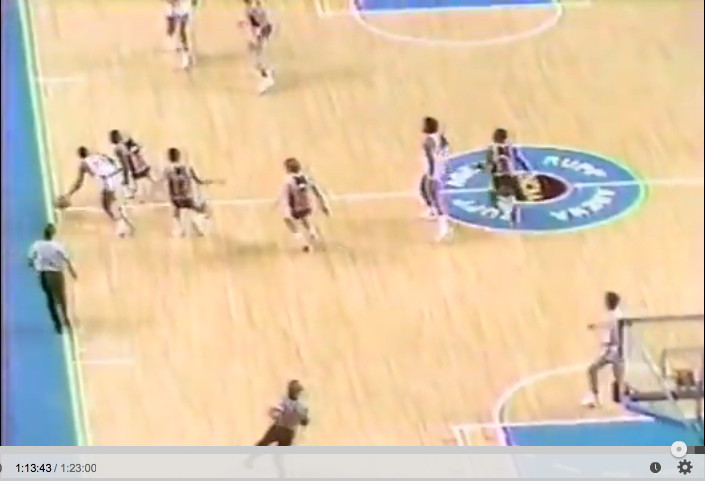
Alt Capture 07b - Beal is dribbling with left foot behind. The ball is just about to be dribbled on the half-court line.
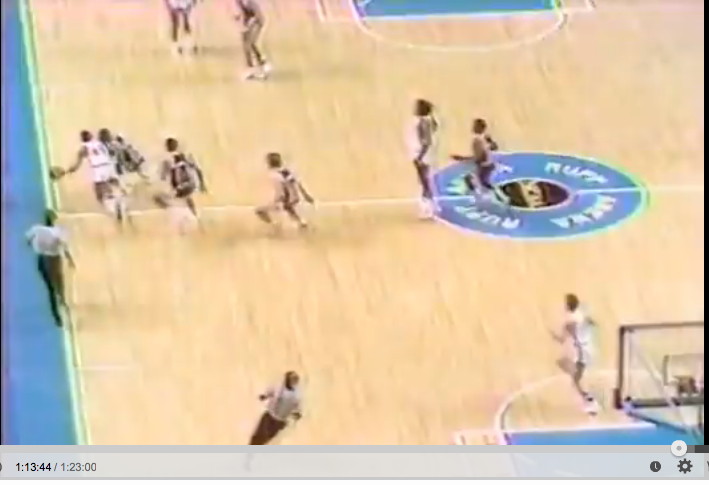
Alt Capture 08a - The ball has bounced back up off the half-court line. Beal is still in dribbling motion with his left foot in the air.
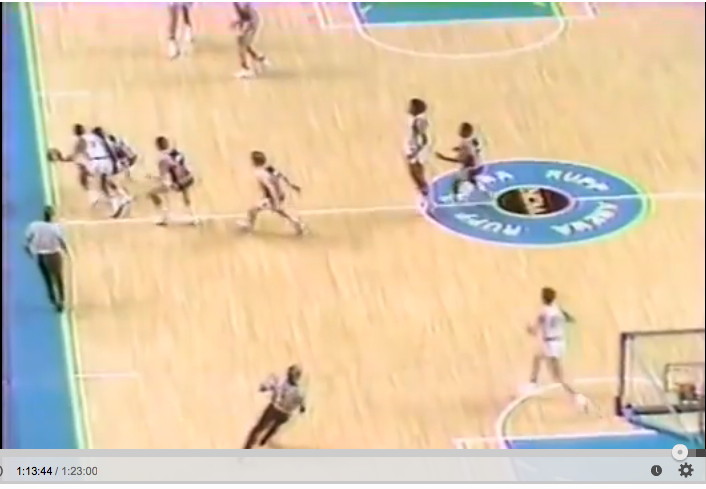
Alt Capture 08aa - Beal's left foot is just about to land on the court. Beal is still in dribbling motion. (note his left hand is still above ball)
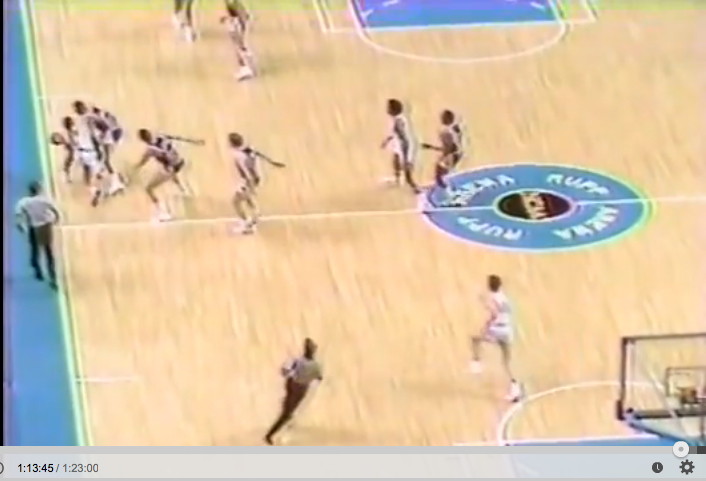
Alt Capture 08aaa - Beal's left foot is contacting ground. Beal appears to still be in dribbling motion. (or possibly he has brought his right hand over to grab the ball, impossible to see from this angle)
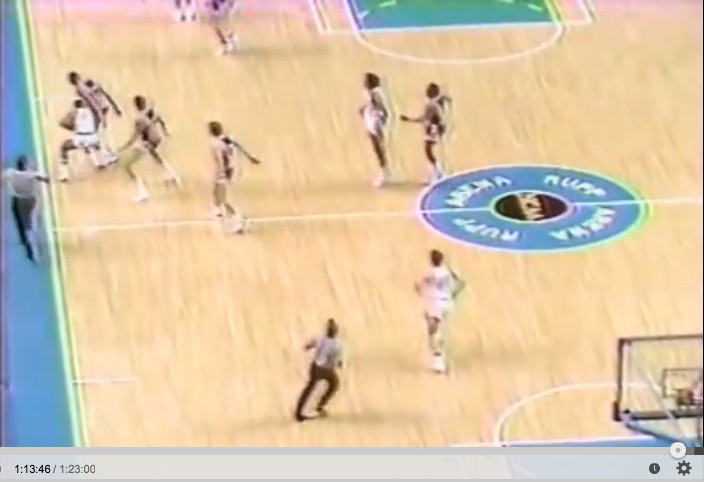
Alt Capture 08bb - Beal's left foot established on the ground as his pivot as he cradles the ball with both hands. Effectively ending his dribbling motion.
Alternative View of 'Foul'
Beyond the claim by some that Beal travelled, there are also claims that Douglas did not foul Beal but simply tied him up. The following screen caps are provided to look at that claim as well. They are alternative views to the ones already provided above (Catpures 15 & 16).
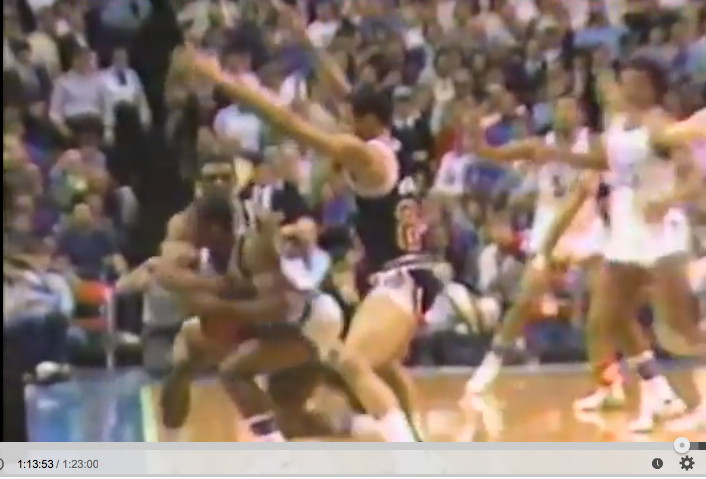
Foul Capture 01 - Bruce Douglas has Beal wrapped up. Douglas does not have the ball, but does have at least his right shoulder.
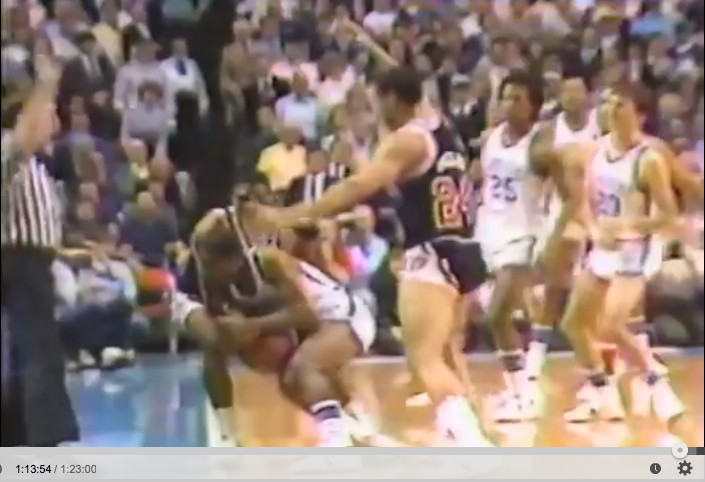
Foul Capture 02 - Beal starts to lose the ball. Official in the process of calling foul. Although difficult to see through the transparency of the Youtube ribbon, Douglas' foot is on the white out-of-bounds line.
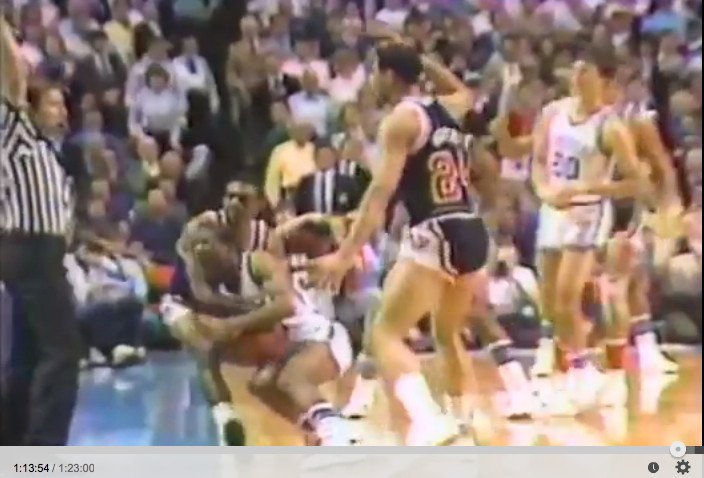
Foul Capture 03 - Both players look at referee making call as they fall out of bounds. Douglas still does not have ball, but he does have a lot of Beal.
Conclusion
Although I assumed that the video by itself is all that would be needed to illustrate my point, the video captures do show very clearly that once Beal made his last dribble on the half-court line, that he planted his left foot and ended his dribble. From that time on Beal retained his left foot as his pivot, and did a good job of keeping it planted in the same spot even as he pivoted around using his right leg to try to avoid two Illini defenders.
Beal did such a good job of retaining his pivot foot that he did so while being fouled and pulled down by Illinois' Bruce Douglas (Douglas BTW never had a clear hold of the ball for a tie-up and in fact Douglas' foot was out of bounds at the time.)
The official was correct in not calling a travel on Beal, and was correct in calling the foul on Bruce Douglas.
![]()
Return to Kentucky Wildcat Basketball Page.
Please send all additions/corrections to